Unit 6 I'm watching TV Section A(1)课件(47张PPT)
文档属性
| 名称 | Unit 6 I'm watching TV Section A(1)课件(47张PPT) | 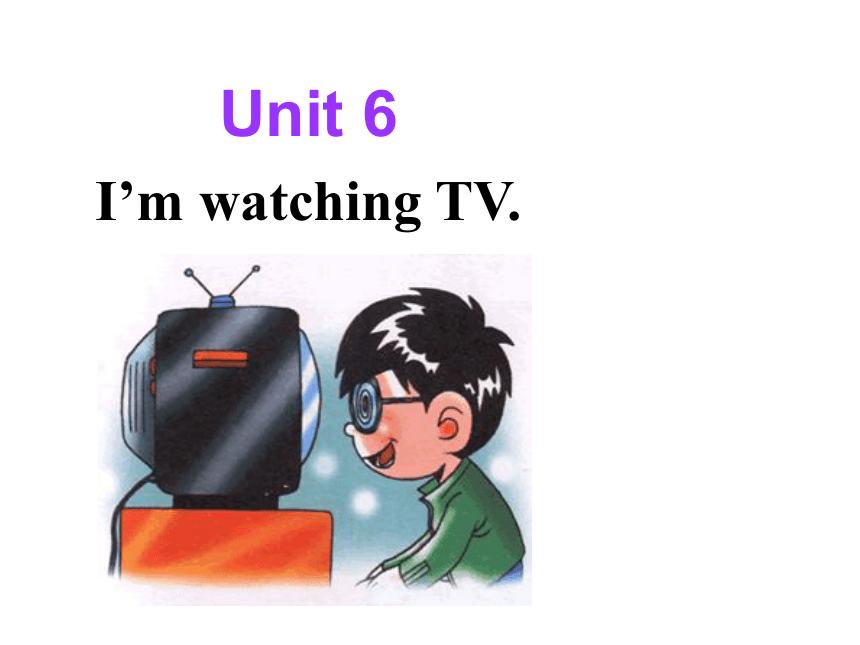 | |
| 格式 | ppt | ||
| 文件大小 | 4.3MB | ||
| 资源类型 | 教案 | ||
| 版本资源 | 人教新目标(Go for it)版 | ||
| 科目 | 英语 | ||
| 更新时间 | 2022-04-27 14:07:25 | ||
图片预览

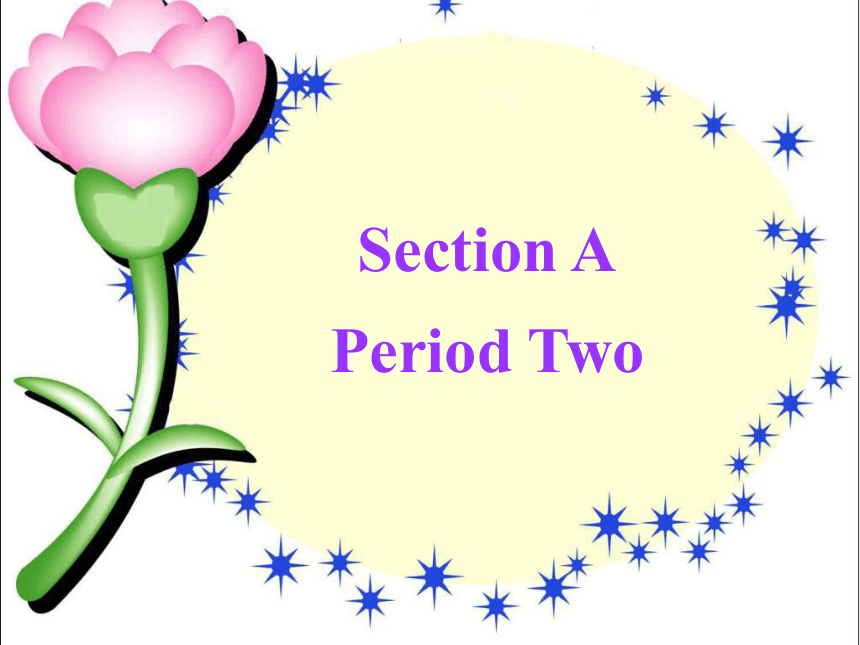
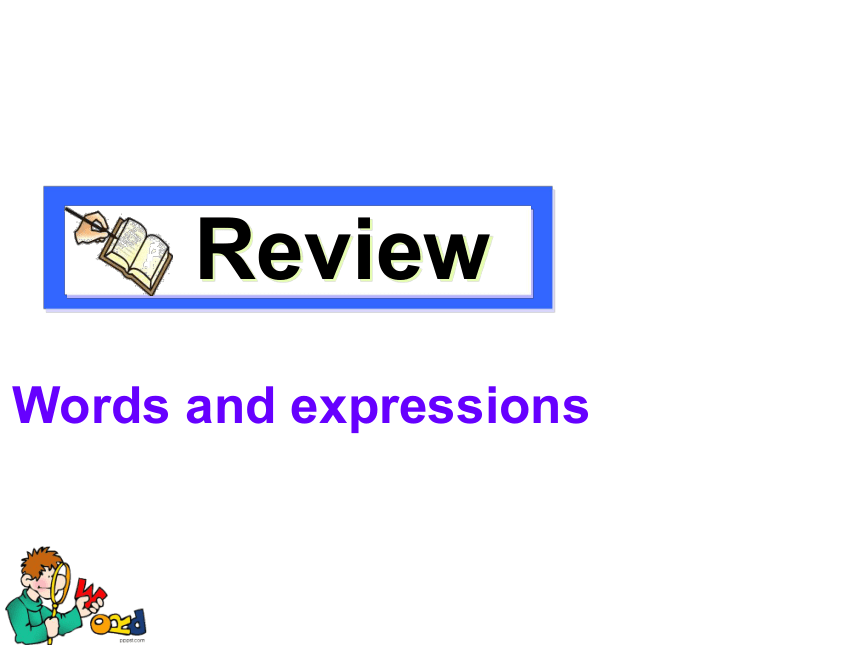

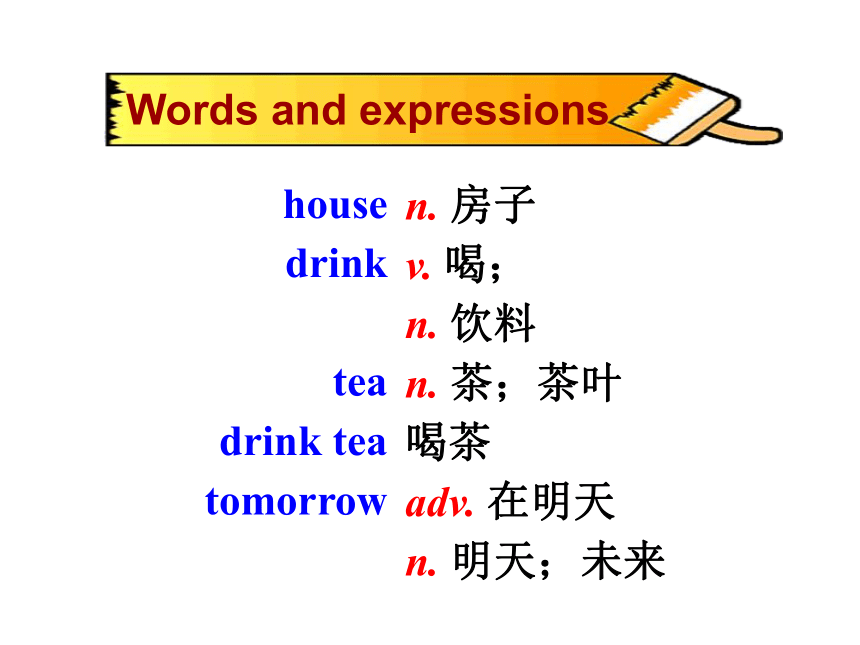
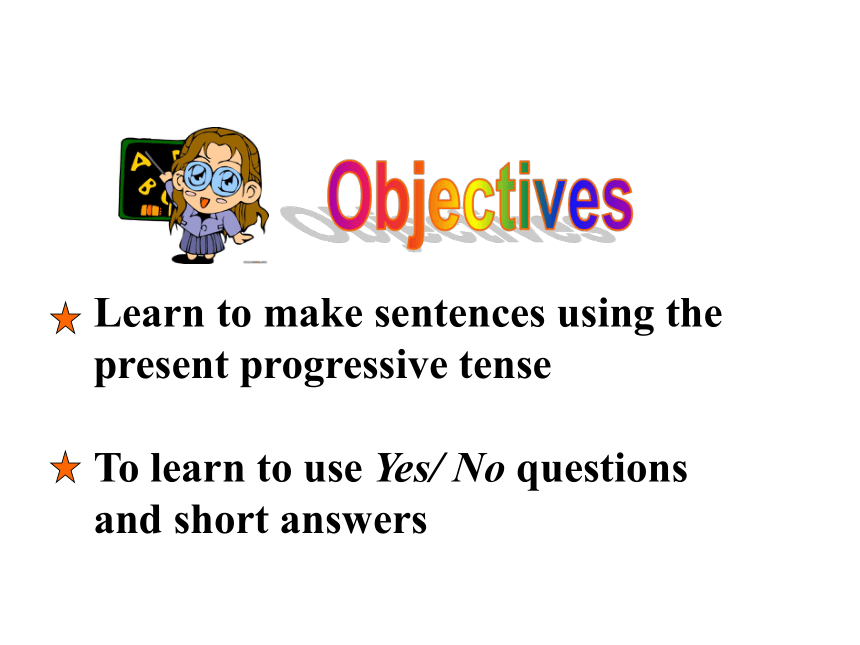
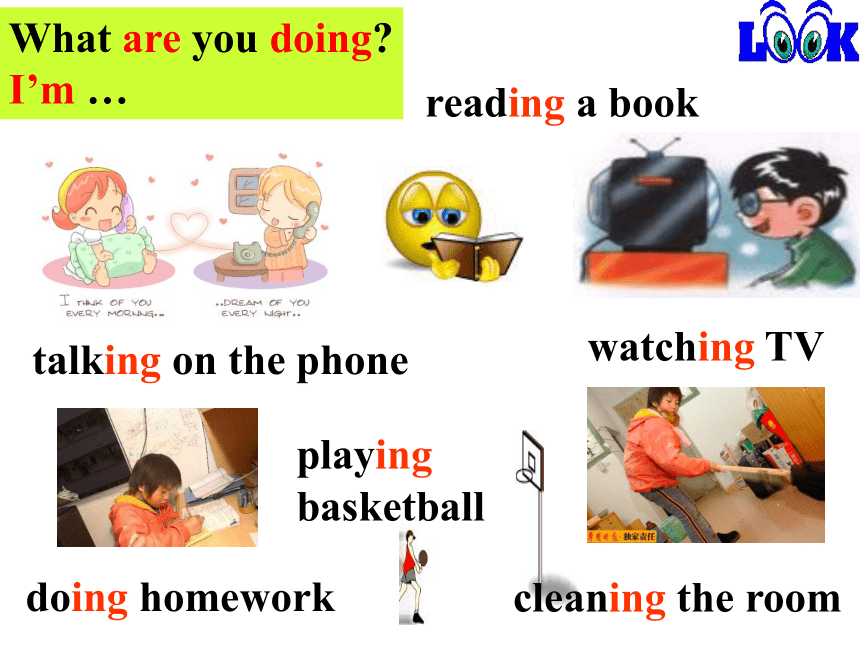
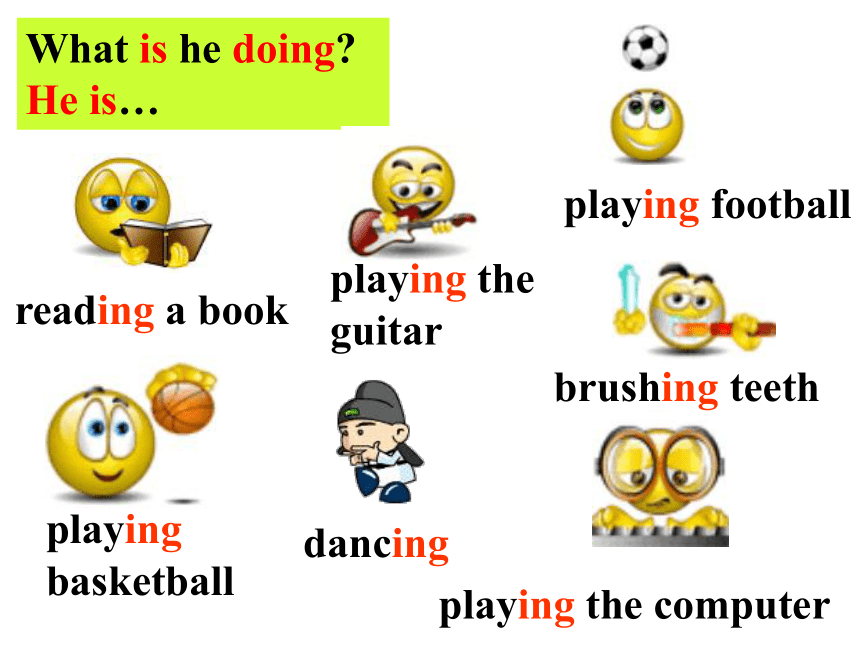
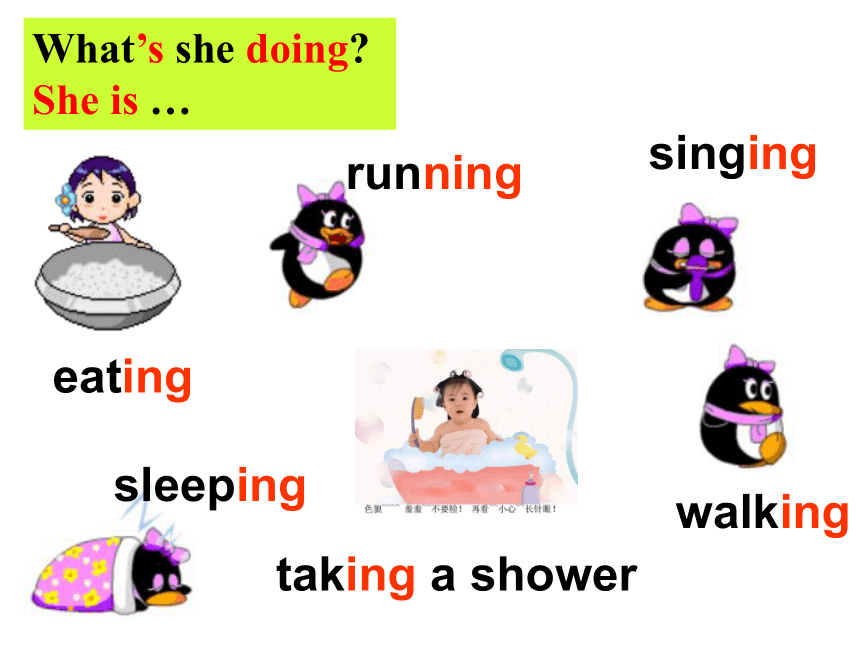
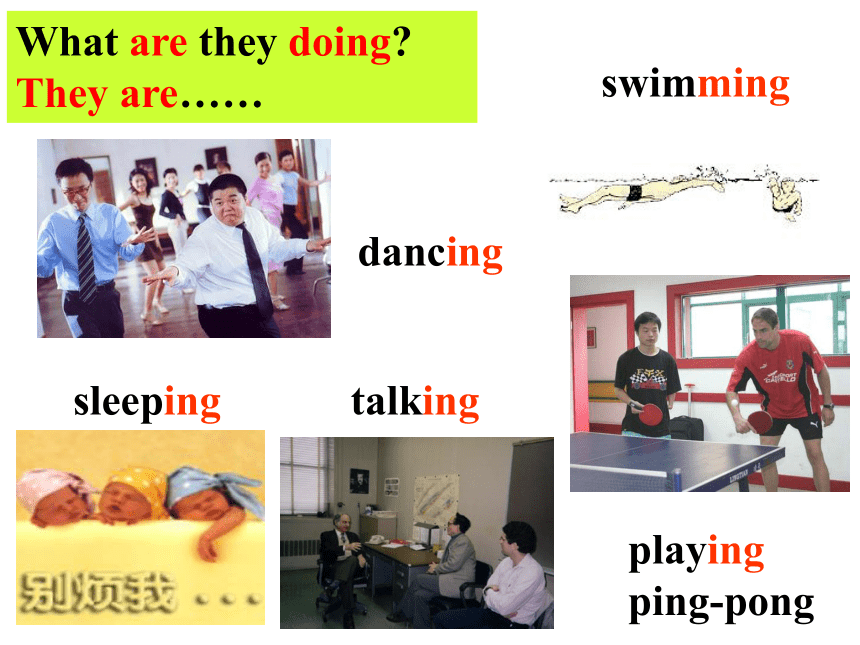

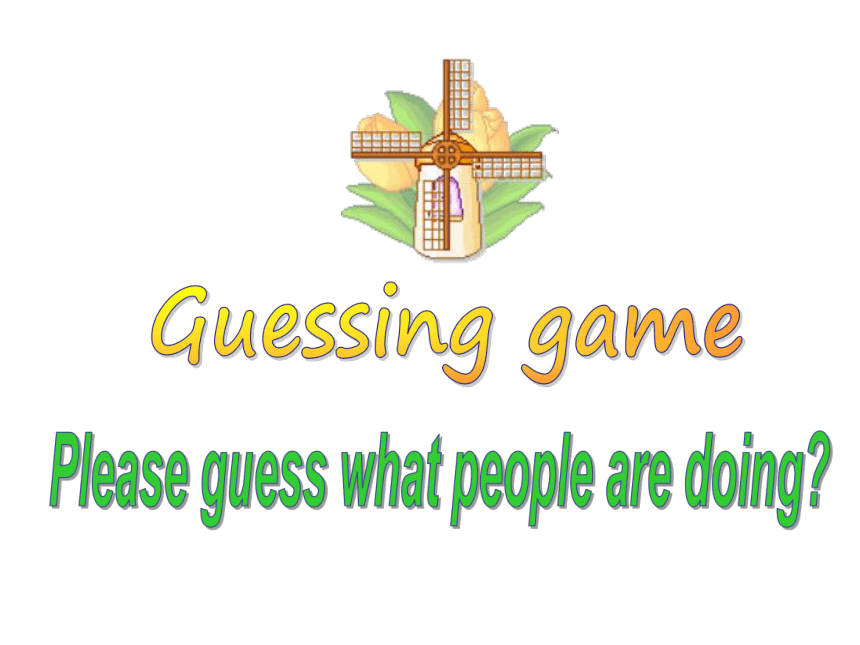
文档简介
(共48张PPT)
Unit 6
I’m watching TV.
Section A
Period Two
Review
Words and expressions
Read the words and expressions loudly.
house
drink
tea
drink tea
tomorrow
n. 房子
v. 喝;
n. 饮料
n. 茶;茶叶
喝茶
adv. 在明天
n. 明天;未来
Words and expressions
Learn to make sentences using the present progressive tense
To learn to use Yes/ No questions and short answers
What are you doing
I’m …
talking on the phone
reading a book
doing homework
watching TV
playing basketball
cleaning the room
What is he doing
He is…
playing
basketball
playing the
guitar
playing the computer
playing football
reading a book
brushing teeth
dancing
eating
What’s she doing
She is …
running
singing
sleeping
walking
taking a shower
What are they doing
They are……
swimming
dancing
sleeping
playing
ping-pong
talking
do___ watch____ clean___
read____ eat____ play____
run_____ swim______
dance _______ write _______
ing
ing
ing
ing
ing
ing
dancing
ning
ming
writing
Do you know how to add “ing”
T: What is she doing
S: Is she…
S: Is she…
…
She is drinking.
T: What is he doing
S: Is he…
S: Is he…
…
He is playing the guitar.
T: What are they doing
S: Are they…
S: Are they…
…
They are dancing.
T: What is he doing
S: Is he…
S: Is he…
…
He is running.
3a
1. Jenny/clean the house/now
____________________________
2. Bob/make dinner/every Saturday
_____________________________
3. Mary’s parents/drink tea/after dinner
_________________________________
4. Bill/talk on the phone/now
____________________________
5. Susan and Bob/watch TV/on weekends
__________________________________
Bob makes dinner every Saturday.
Mary’s parents drink tea after dinner.
Bill is talking on the phone now.
Write sentences following the examples.
Jenny is cleaning the house now.
Susan and Bob watch TV on weekends.
3b
___ Do you want to go tomorrow then
___ OK. See you tomorrow evening.
___ I’m reading a book.
___ Let’s go at seven o’clock.
___ No, this book is really interesting.
___ What are you doing
___ Do you want to go to the movies now
___ Sure, what time
1
3
4
Number the sentences in order to make a telephone conversation. Then practice it with a partner.
2
5
8
7
6
Pair work
Practice the conversation. Then talk as they do with your partner.
A: Do you want to go to the park
B: Sure, this book is boring.
A: When do you want to go
B: Let’s go at two o’clock.
3c
Take turns making different activities in your group. The others in the group guess what the activities are.
Two teams will have a race. The team that first give was/were v-ing sentence will get one point.
Team racing
Activity
Speaking Practice
Ready
teaching
taking a photo
barbecuing
at 8 o’clock last Sunday morning
pulling
pushing
running
swimming
painting
dancing
jumping
riding
singing
drinking
lifting
climbing
relaxing
writing
playing basketball
1. 基本用法:
现在进行时可表示现在(说话时)正在进行
或发生的动作,也可表示当前一段时间内
的活动或现阶段正在进行的动作。如:
My father is reading newspapers now.
She is studying English these days.
现在进行时
2. 构成及句型结构:
现在进行时由“助动词be (am, is, are) +
动词-ing形式”构成。
肯定式:主语 + am / is / are + 动词-ing +
其他。
如:My mother is cooking dinner in the kitchen (厨房).
否定式:主语+ am / is / are + not + 动
词-ing + 其他。如:My mother isn’t cooking dinner in the kitchen.
一般疑问句:Am / Is / Are + 主语 + 动
词-ing + 其他 肯定回答:Yes, 主语 + am / is / are。否定回答:No, 主语 + am not / isn’t / aren’t。
如:— Is your mother cooking dinner
in the kitchen
— Yes, she is. / No, she isn’t.
特殊疑问句:疑问词 + am / is / are +主语 + 动词-ing + 其他 如:
My mother is cooking dinner in the kitchen. → Where is your mother cooking dinner
现在进行时不同于一般现在时,通常在特定的情况下才使用。那么,什么时候使用现在进行时呢?
1. 表示现在正在进行的动作,时间状语为now时,通常用现在进行时。如:
Steve is playing soccer now.
2. 当句子的开头为Look!或Listen!等时,表明说话时动作正在进行,应该用现在进行时。如:
Look! They are swimming in the river.
何时使用现在进行时
3. 描述图片中人物的动作时,常用现在进行时,使画面更生动。如:
Look at the picture! The children are
playing games in the park.
4. 当句子前后的语境、时间等暗示动作正在发生时,也通常用现在进行时。
如:
— Where is Lily
— She is on the sofa. She is watching TV.
1. do (one’s) homework 做作业, 其中
one’s 指物主代词,且和主语保持一致。
We do our homework in the evening.
我们在晚上做作业。
He often does his homework at
home.
他经常在家做作业。
词语链接
2. watch TV 看电视
watch, see, look, 这三个词的区别:
1) watch
意为“观看、注视”, 指长时间看
某一活动的场面,如:看电视、
比赛、表演、赏月等。
He likes watching TV.
他喜欢看电视。
2) look
强调发出看的动作,不注重结果, 是
一个不及物动词,带宾语时加at。
如:
Look. There is a boy under the tree.
看,树下有一个男孩。
Please look at the blackboard.
请看黑板。
3) see
强调“看的结果”, 指看见还是没看见。
也指看电影 (see a film) 或看病
(see a doctor)。
如:
I can see some birds in the tree.
我能看见树上有一些鸟。
3. Let’s + 动词原形
表 “建议”, 意为:
“让我们做……”
Let’s see the tigers first.
让我们先看老虎吧。
课时重点回顾
A: Do you want to…
B: Sure, what time
B: Let’s go at ....
A: OK. See you then!
A: What are you doing
B: I’m ...
A: Do you want to …
B: Sure, when do you want to go
A: Let’s go at ...
课时重点回顾
-Is he reading a newspaper
Yes, he is. /No, he isn’t. He’s playing
basketball.
-Are you doing your homework
-Yes, I am./No, I’m not. I’m cleaning my
room.
-Are they using the computer
-Yes, they are./No, they aren’t. They’re
exercising.
课时重点回顾
She is exercising (now).
She exercises (on Mondays/every night/
in the mornings/etc.)
注: 另附word文档。
点击此处链接
用所给动词的现在进行时态填空。
1. My parents ___________(talk) about
me now.
2. Look! Three boys ___________(run).
3. What ___ your mother ______(do) now
4. ____ your dog _______(sleep) now
5. — _____ you _______(listen) to music
— Yes, I am.
are talking
are running
is doing
Is sleeping
Are listening
按要求改写句子,每空一词。
1. Nancy is watching TV. (改为否定句)
Nancy ______ ________ TV.
2. Bill is doing his homework.
(改为一般疑问句,并作否定回答)
— ____ Bill _______ his homework
— No, he _______.
3. Mary is reading a book.
(对划线部分提问)
______ ____ Mary _______
What is doing
isn’t watching
Is doing
isn’t
Translate and write them down.
1. - 你想去看电影吗?
- 当然了,什么时候去?
- 我们七点去。
2. 他正在等公共汽车。
- Do you want to go to the movies
Sure, when do you want to go
Let’s go at seven o’clock.
He is waiting for a bus.
3. 那些男孩现在正和老师们打篮球。
4. 听!你哥哥在弹吉他。
The boys are playing basketball with their teachers now.
Listen! Your brother is playing the
guitar.
5. 这是一张成龙的照片。他正在唱歌。
6. 孩子们不在房间里。他们在花园里做
游戏。
The kids aren’t in the room. They are playing games in the garden.
This is a photo of Jackie Chan. He’s
singing.
To preview the new words and expressions
To preview the places and activities in 1a of Section B
Unit 6
I’m watching TV.
Section A
Period Two
Review
Words and expressions
Read the words and expressions loudly.
house
drink
tea
drink tea
tomorrow
n. 房子
v. 喝;
n. 饮料
n. 茶;茶叶
喝茶
adv. 在明天
n. 明天;未来
Words and expressions
Learn to make sentences using the present progressive tense
To learn to use Yes/ No questions and short answers
What are you doing
I’m …
talking on the phone
reading a book
doing homework
watching TV
playing basketball
cleaning the room
What is he doing
He is…
playing
basketball
playing the
guitar
playing the computer
playing football
reading a book
brushing teeth
dancing
eating
What’s she doing
She is …
running
singing
sleeping
walking
taking a shower
What are they doing
They are……
swimming
dancing
sleeping
playing
ping-pong
talking
do___ watch____ clean___
read____ eat____ play____
run_____ swim______
dance _______ write _______
ing
ing
ing
ing
ing
ing
dancing
ning
ming
writing
Do you know how to add “ing”
T: What is she doing
S: Is she…
S: Is she…
…
She is drinking.
T: What is he doing
S: Is he…
S: Is he…
…
He is playing the guitar.
T: What are they doing
S: Are they…
S: Are they…
…
They are dancing.
T: What is he doing
S: Is he…
S: Is he…
…
He is running.
3a
1. Jenny/clean the house/now
____________________________
2. Bob/make dinner/every Saturday
_____________________________
3. Mary’s parents/drink tea/after dinner
_________________________________
4. Bill/talk on the phone/now
____________________________
5. Susan and Bob/watch TV/on weekends
__________________________________
Bob makes dinner every Saturday.
Mary’s parents drink tea after dinner.
Bill is talking on the phone now.
Write sentences following the examples.
Jenny is cleaning the house now.
Susan and Bob watch TV on weekends.
3b
___ Do you want to go tomorrow then
___ OK. See you tomorrow evening.
___ I’m reading a book.
___ Let’s go at seven o’clock.
___ No, this book is really interesting.
___ What are you doing
___ Do you want to go to the movies now
___ Sure, what time
1
3
4
Number the sentences in order to make a telephone conversation. Then practice it with a partner.
2
5
8
7
6
Pair work
Practice the conversation. Then talk as they do with your partner.
A: Do you want to go to the park
B: Sure, this book is boring.
A: When do you want to go
B: Let’s go at two o’clock.
3c
Take turns making different activities in your group. The others in the group guess what the activities are.
Two teams will have a race. The team that first give was/were v-ing sentence will get one point.
Team racing
Activity
Speaking Practice
Ready
teaching
taking a photo
barbecuing
at 8 o’clock last Sunday morning
pulling
pushing
running
swimming
painting
dancing
jumping
riding
singing
drinking
lifting
climbing
relaxing
writing
playing basketball
1. 基本用法:
现在进行时可表示现在(说话时)正在进行
或发生的动作,也可表示当前一段时间内
的活动或现阶段正在进行的动作。如:
My father is reading newspapers now.
She is studying English these days.
现在进行时
2. 构成及句型结构:
现在进行时由“助动词be (am, is, are) +
动词-ing形式”构成。
肯定式:主语 + am / is / are + 动词-ing +
其他。
如:My mother is cooking dinner in the kitchen (厨房).
否定式:主语+ am / is / are + not + 动
词-ing + 其他。如:My mother isn’t cooking dinner in the kitchen.
一般疑问句:Am / Is / Are + 主语 + 动
词-ing + 其他 肯定回答:Yes, 主语 + am / is / are。否定回答:No, 主语 + am not / isn’t / aren’t。
如:— Is your mother cooking dinner
in the kitchen
— Yes, she is. / No, she isn’t.
特殊疑问句:疑问词 + am / is / are +主语 + 动词-ing + 其他 如:
My mother is cooking dinner in the kitchen. → Where is your mother cooking dinner
现在进行时不同于一般现在时,通常在特定的情况下才使用。那么,什么时候使用现在进行时呢?
1. 表示现在正在进行的动作,时间状语为now时,通常用现在进行时。如:
Steve is playing soccer now.
2. 当句子的开头为Look!或Listen!等时,表明说话时动作正在进行,应该用现在进行时。如:
Look! They are swimming in the river.
何时使用现在进行时
3. 描述图片中人物的动作时,常用现在进行时,使画面更生动。如:
Look at the picture! The children are
playing games in the park.
4. 当句子前后的语境、时间等暗示动作正在发生时,也通常用现在进行时。
如:
— Where is Lily
— She is on the sofa. She is watching TV.
1. do (one’s) homework 做作业, 其中
one’s 指物主代词,且和主语保持一致。
We do our homework in the evening.
我们在晚上做作业。
He often does his homework at
home.
他经常在家做作业。
词语链接
2. watch TV 看电视
watch, see, look, 这三个词的区别:
1) watch
意为“观看、注视”, 指长时间看
某一活动的场面,如:看电视、
比赛、表演、赏月等。
He likes watching TV.
他喜欢看电视。
2) look
强调发出看的动作,不注重结果, 是
一个不及物动词,带宾语时加at。
如:
Look. There is a boy under the tree.
看,树下有一个男孩。
Please look at the blackboard.
请看黑板。
3) see
强调“看的结果”, 指看见还是没看见。
也指看电影 (see a film) 或看病
(see a doctor)。
如:
I can see some birds in the tree.
我能看见树上有一些鸟。
3. Let’s + 动词原形
表 “建议”, 意为:
“让我们做……”
Let’s see the tigers first.
让我们先看老虎吧。
课时重点回顾
A: Do you want to…
B: Sure, what time
B: Let’s go at ....
A: OK. See you then!
A: What are you doing
B: I’m ...
A: Do you want to …
B: Sure, when do you want to go
A: Let’s go at ...
课时重点回顾
-Is he reading a newspaper
Yes, he is. /No, he isn’t. He’s playing
basketball.
-Are you doing your homework
-Yes, I am./No, I’m not. I’m cleaning my
room.
-Are they using the computer
-Yes, they are./No, they aren’t. They’re
exercising.
课时重点回顾
She is exercising (now).
She exercises (on Mondays/every night/
in the mornings/etc.)
注: 另附word文档。
点击此处链接
用所给动词的现在进行时态填空。
1. My parents ___________(talk) about
me now.
2. Look! Three boys ___________(run).
3. What ___ your mother ______(do) now
4. ____ your dog _______(sleep) now
5. — _____ you _______(listen) to music
— Yes, I am.
are talking
are running
is doing
Is sleeping
Are listening
按要求改写句子,每空一词。
1. Nancy is watching TV. (改为否定句)
Nancy ______ ________ TV.
2. Bill is doing his homework.
(改为一般疑问句,并作否定回答)
— ____ Bill _______ his homework
— No, he _______.
3. Mary is reading a book.
(对划线部分提问)
______ ____ Mary _______
What is doing
isn’t watching
Is doing
isn’t
Translate and write them down.
1. - 你想去看电影吗?
- 当然了,什么时候去?
- 我们七点去。
2. 他正在等公共汽车。
- Do you want to go to the movies
Sure, when do you want to go
Let’s go at seven o’clock.
He is waiting for a bus.
3. 那些男孩现在正和老师们打篮球。
4. 听!你哥哥在弹吉他。
The boys are playing basketball with their teachers now.
Listen! Your brother is playing the
guitar.
5. 这是一张成龙的照片。他正在唱歌。
6. 孩子们不在房间里。他们在花园里做
游戏。
The kids aren’t in the room. They are playing games in the garden.
This is a photo of Jackie Chan. He’s
singing.
To preview the new words and expressions
To preview the places and activities in 1a of Section B
同课章节目录
- Unit 1 Can you play the guitar?
- Section A
- Section B
- Unit 2 What time do you go to school?
- Section A
- Section B
- Unit 3 How do you get to school?
- Section A
- Section B
- Unit 4 Don't eat in class.
- Section A
- Section B
- Unit 5 Why do you like pandas?
- Section A
- Section B
- Unit 6 I'm watching TV.
- Section A
- Section B
- Review of Units 1-6
- Unit 7 It's raining!
- Section A
- Section B
- Unit 8 Is there a post office near here?
- Section A
- Section B
- Unit 9 What does he look like?
- Section A
- Section B
- Unit 10 I'd like some noodles.
- Section A
- Section B
- Unit 11 How was your school trip?
- Section A
- Section B
- Unit 12 What did you do last weekend?
- Section A
- Section B
